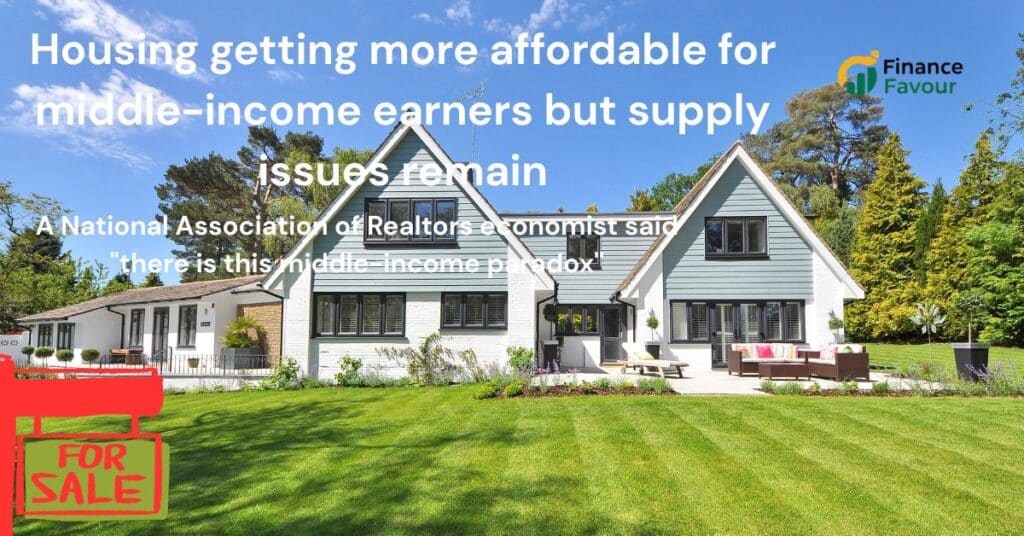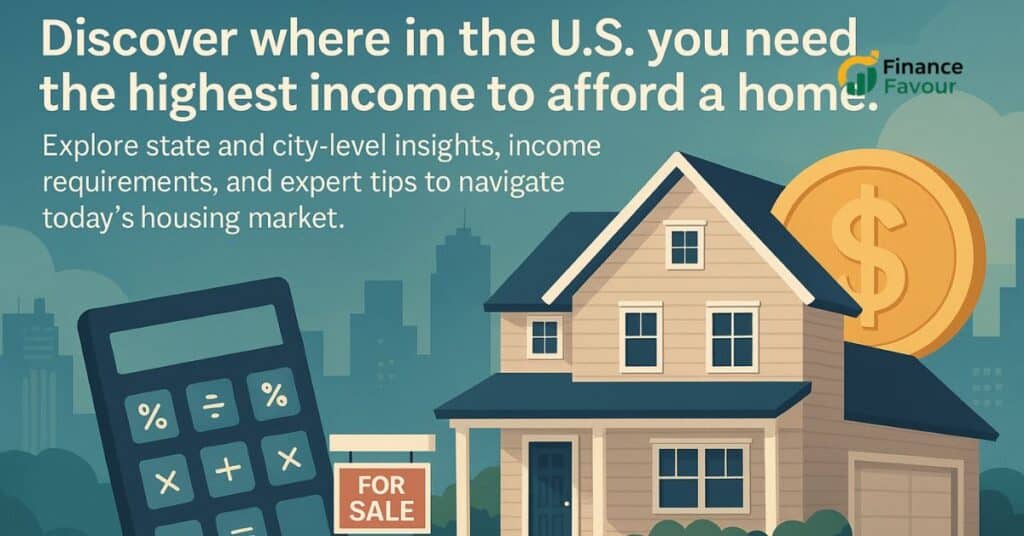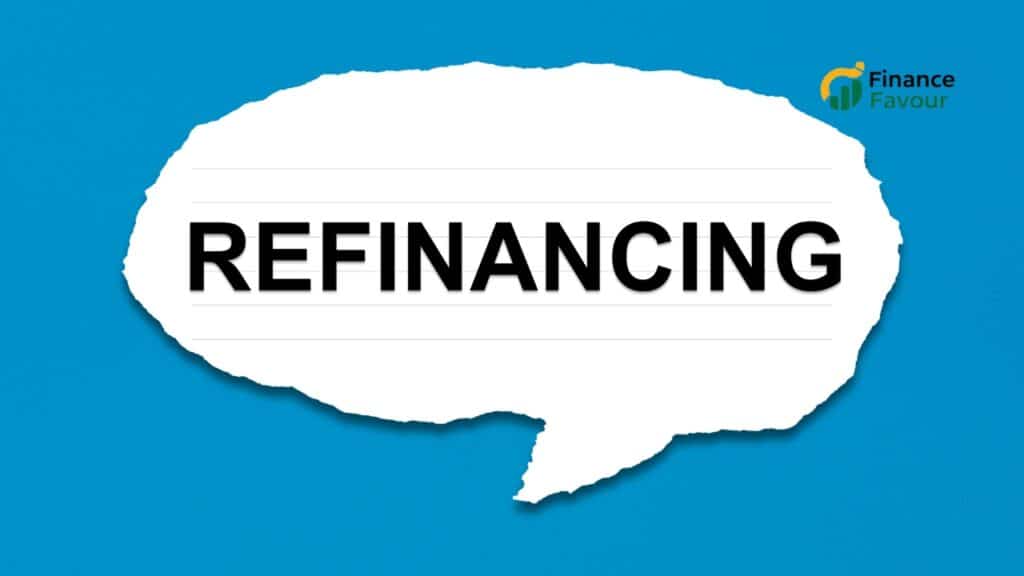It’s been a wild ride in the U.S. housing market over the past few years. Skyrocketing prices, pandemic-driven shifts in where and how people live, and intense buyer competition turned homeownership into what often felt like a pipe dream especially for middle-income Americans. But the tide is turning. New data shows that this segment of the population is starting to regain its footing in the housing market, a glimmer of hope in an otherwise challenging landscape.
Still, it’s not all smooth sailing. While middle-income families are finding more opportunities to buy homes, one massive roadblock continues to cast a long shadow: affordability. The average home price continues to climb faster than wages, inventory is tight, and institutional investors are snapping up properties at record speed. This article takes a deep dive into how middle-income Americans are gaining traction, what’s fueling this momentum, and why affordability remains the Achilles’ heel of housing access.
Who Are Middle-Income Americans?
Before we dive into market trends, let’s clarify who we’re talking about. Middle-income Americans generally fall into households earning between 67% and 200% of the national median income. According to the Pew Research Center, that’s roughly $50,000 to $150,000 annually for a household, though the actual range varies depending on the number of earners and geographic location.
For example, a middle-income household in Des Moines, Iowa might comfortably afford a modest single-family home, while the same household in San Francisco or New York City could be priced out of even a small condo. Geography plays a critical role, which means middle-income status isn’t a one-size-fits-all definition.
Additionally, the middle-income bracket encompasses a wide range of professionals: teachers, nurses, small business owners, skilled tradespeople, and office workers, to name a few. These are the backbone workers of the American economy people who keep communities running and economies humming. Their path to homeownership isn’t just a personal dream it’s a marker of economic health and mobility for the nation.
Housing Market Recovery for Middle-Income Buyers
For a long time, the housing market wasn’t kind to the middle-income crowd. After the 2008 financial crisis, millions lost their homes or were unable to buy due to tightened lending standards and stagnant wages. By the time the market began to recover, prices were already soaring, putting ownership further out of reach.
But in the past couple of years, there’s been a noticeable shift. Thanks to a mix of stabilizing mortgage rates, government incentives, and targeted development in suburban and exurban areas, middle-income families are stepping back into the market. According to a recent study by the National Association of Realtors, middle-income buyers accounted for more than 40% of new home purchases in the past 12 months a major jump from the previous decade.
Why now? Part of the answer lies in changing priorities. The pandemic triggered a mass reevaluation of work-life balance and long-term goals. Many people who were previously renting in urban centers began seeking more space and stability especially as remote work took hold and allowed for greater geographic flexibility. These shifts created openings in smaller cities and rural communities where housing is more affordable and competition less intense.
Surge in First-Time Homebuyers
One of the most promising signs of recovery is the increase in first-time homebuyers. These are often young families, millennials, and Gen Zers breaking into the market for the first time. According to Zillow, nearly 45% of homes sold in 2024 were purchased by first-time buyers many of them falling squarely into the middle-income bracket.
This surge isn’t just a blip; it reflects broader demographic trends. Millennials, now the largest adult generation, are hitting their peak homebuying years. They’ve spent the last decade paying off student debt, saving down payments, and improving credit scores. For many, the timing finally feels right, and the market is beginning to reward their patience.
First-time buyers also benefit from special programs that offer lower down payments, favorable interest rates, and even grants. These financial tools reduce entry barriers and make it easier for middle-income earners to plant roots and build equity.
Increased Access to Mortgage Options
Another driving factor behind the middle-income rebound is the expansion of accessible mortgage products. Agencies like the Federal Housing Administration (FHA) and the Department of Veterans Affairs (VA) have played a pivotal role. These programs are designed to support buyers who may not qualify for conventional loans due to limited savings or lower credit scores.
Additionally, many banks and credit unions have begun offering specialized loan packages for middle-income buyers particularly those with steady employment histories and strong debt-to-income ratios. This is a far cry from the post-2008 era, when lenders adopted an overly cautious stance that often excluded all but the most financially privileged.
And let’s not forget about mortgage interest rates. While they’ve fluctuated wildly, the general trend has remained below historical averages. Even a slight dip can make a huge difference in monthly payments, tipping the scales in favor of affordability for budget-conscious buyers.
Affordable Housing Developments
Affordable housing is no longer just a buzzword it’s becoming a cornerstone of community development strategies across the country. For middle-income Americans, the proliferation of affordable housing developments in suburban, exurban, and even some urban fringe areas has opened doors that were previously locked tight. These new neighborhoods are intentionally designed to cater to modest earners, featuring practical, energy-efficient homes with flexible financing options.
Suburban regions around cities like Charlotte, Nashville, and Phoenix are leading the charge. Developers, often in partnership with municipal governments, are building mixed-use communities that include a healthy mix of single-family homes, townhouses, and rental units. These neighborhoods prioritize walkability, access to public transit, and proximity to job hubs all without the premium pricing of downtown districts.
One standout trend is the growth of “starter home” models: compact, smartly designed homes priced well below the regional median. These homes target families and individuals looking to own without overextending financially. Plus, with modern construction techniques like modular housing and 3D-printed components, builders can reduce costs and pass those savings on to buyers.
Role of Public-Private Partnerships
Much of this development is made possible through public-private partnerships (PPPs), a collaborative approach that merges government support with private sector innovation. In these arrangements, local governments may offer land grants, tax incentives, or streamlined permitting processes in exchange for developers committing to build a certain percentage of affordable housing.
These partnerships ensure that new construction isn’t exclusively geared toward luxury buyers or investors. Instead, they balance profitability with social responsibility, helping to create inclusive communities where teachers, firefighters, and other essential workers can afford to live.
PPPs also foster long-term stability. By requiring that a percentage of homes remain below market rate for a set period, often 10–30 years, they protect against speculative price hikes and gentrification that would otherwise displace the very families they aim to help.
Zoning Law Adjustments and Their Effects
Zoning laws have long been a thorn in the side of affordable housing advocates. Historically, many U.S. cities have used single-family zoning to limit density and maintain exclusivity, effectively blocking the development of more affordable multi-family units. But that’s beginning to change.
Cities like Minneapolis and Portland have led the charge by reforming their zoning codes to allow for duplexes, triplexes, and small apartment buildings in areas that were once restricted to single-family homes. This kind of upzoning creates more housing supply without drastically altering the character of a neighborhood.
The effects are significant. More housing units mean more opportunities for middle-income buyers to find homes within their budgets. It also encourages more diverse communities, as people from different income brackets can live in closer proximity. Additionally, increased density reduces urban sprawl and supports more efficient public transportation systems benefits that ripple across the economy.
Tech’s Role in Democratizing Homeownership
Technology is leveling the playing field for homebuyers in ways we couldn’t have imagined a decade ago. From browsing listings on your phone to submitting mortgage applications online, the digital revolution has made it easier than ever for middle-income Americans to navigate the housing market.
Real estate platforms like Zillow, Redfin, and Realtor provide transparent pricing, neighborhood data, and instant updates on new listings. This visibility empowers buyers to make informed decisions quickly, a crucial advantage in competitive markets. It also removes some of the mystique and gatekeeping that used to make homebuying feel like a club for the elite.
Financial technology has played an equally transformative role. Budgeting apps, mortgage calculators, and credit score monitors allow prospective buyers to plan ahead, identify what they can afford, and prepare for the loan process with confidence. In other words, tech tools are helping middle-income earners become financially literate and proactive consumers.
Virtual Tours and Online Applications
Virtual tours are a game-changer, especially for buyers with tight schedules or limited geographic flexibility. Instead of attending open houses in person, potential buyers can explore properties through immersive 3D walkthroughs and live-streamed video tours. This is particularly beneficial for people relocating for work or moving from one state to another situations where middle-income families often find themselves.
Online mortgage applications have also streamlined the process. In the past, securing a mortgage meant stacks of paperwork and multiple in-person meetings. Now, digital platforms can assess creditworthiness, verify employment, and even issue pre-approvals in under 48 hours. This speed and convenience reduce the friction that previously deterred many would-be homeowners from taking the plunge.
The result? A more inclusive market where the barriers to entry time, knowledge, and access are being dismantled one app at a time.
Crowdfunding and Co-Buying Models
Not everyone can buy a house the traditional way, and that’s where innovative financing models come in. Crowdfunding platforms allow buyers to raise down payments from friends, family, and even strangers who want to invest in someone’s homeownership journey. Sites like HomeFundIt have seen increasing traction among middle-income earners looking to close the financial gap.
Co-buying is another growing trend. Friends, siblings, or unmarried partners pool resources to buy property together, thereby sharing the financial burden and increasing their purchasing power. While this approach comes with legal and logistical complexities, it opens doors for buyers who might otherwise remain renters indefinitely.
These alternative models represent a broader shift toward flexibility and creativity in the housing finance world. They acknowledge that the old rules don’t work for everyone and that’s especially true for middle-income Americans navigating today’s high-cost market.
The Major Roadblock: Housing Affordability Crisis
Despite all the progress, housing affordability remains the towering obstacle in the path of middle-income Americans. While more buyers are getting their foot in the door, the financial pressure to stay there or even find a door to begin with is intensifying. According to the U.S. Census Bureau and HUD data, more than 50% of middle-income families are “cost-burdened,” meaning they spend over 30% of their income on housing.
The root of the issue? A classic mismatch of supply and demand. There simply aren’t enough homes to go around, especially in growing cities and desirable neighborhoods. Builders struggle with rising costs for land, labor, and materials. And in many areas, outdated zoning laws and local resistance to new development slow down construction timelines.
Even as wages slowly rise, they haven’t kept pace with home price inflation. The National Association of Home Builders reports that in 2024, the average cost of a newly constructed home hit an all-time high—putting it out of reach for most middle-income earners. When your income can’t stretch to match your mortgage, the American Dream becomes harder to grasp.
Wage Growth vs. Home Price Inflation
It’s no secret that wages have grown slower than home prices over the past two decades. While some sectors like tech and finance have seen respectable income growth, many middle-class professions teaching, healthcare support, retail haven’t kept pace. The result is a widening affordability gap.
Let’s break it down: From 2012 to 2024, the median household income in the U.S. rose by about 20%, while the average home price rose by more than 45%. That gap is even wider in coastal states like California and Massachusetts, where housing prices can skyrocket by 60% or more in a decade.
This mismatch forces middle-income buyers to make tough choices: longer commutes, smaller homes, or even delaying homeownership altogether. In some cases, it pushes them out of the market entirely, trapping them in high-cost rental cycles that prevent them from building wealth or equity.
Institutional Investors in Residential Real Estate
Another major barrier is competition not just from other families, but from big institutional investors. Over the last few years, firms like Blackstone, Invitation Homes, and other hedge funds have entered the residential real estate market in a big way. They’re not buying one or two homes they’re buying hundreds or thousands, sometimes entire new developments.
These firms often pay in cash and above asking price, making it nearly impossible for middle-income buyers to compete. What’s worse, they typically turn these properties into rentals, further shrinking the pool of available homes for purchase.
The scale of this problem is alarming. In some suburban markets, investors account for more than 25% of all home purchases. This drives prices up, reduces inventory, and creates an uneven playing field where ordinary Americans simply can’t win.
Policy and Legislative Responses
Recognizing the crisis, lawmakers at every level are stepping in. From federal tax credits to state-level construction incentives, the government is finally taking meaningful steps to support middle-income homebuyers.
One key area of focus is expanding access to housing tax credits. These programs reduce the tax burden for buyers, effectively lowering the cost of homeownership. At the federal level, the Biden administration has proposed a $10,000 tax credit for first-time homebuyers, though it still faces hurdles in Congress.
States like California and New York are experimenting with “missing middle” housing initiatives, which provide subsidies for developers to build duplexes, triplexes, and small apartment complexes. These are the kinds of units that middle-income families can actually afford—filling the critical gap between luxury condos and low-income housing.
Expansion of Rent-to-Own Programs
Rent-to-own programs are gaining traction as a transitional option for would-be homeowners. These models allow tenants to rent a home with the option to buy after a set period. A portion of their monthly rent goes toward a future down payment, making it easier to accumulate savings over time.
Programs like Divvy Homes and Landis are leading the charge. They offer credit counseling, savings plans, and flexible leasing terms, giving middle-income renters a clear path to ownership. While not perfect there are risks involved if buyers fail to qualify for a mortgage later these programs offer hope for families stuck in the rent trap.
In some cities, public housing authorities are even piloting rent-to-own options for Section 8 voucher recipients, proving that homeownership doesn’t have to be reserved for the elite.
Interest Rate Policy and Its Ripple Effects
Finally, we can’t talk about housing without addressing interest rates. The Federal Reserve’s policies have a huge influence on mortgage costs. When rates are low, buyers can afford more house for the same monthly payment. When rates spike, affordability shrinks fast.
Over the past two years, we’ve seen both extremes. In 2021, record-low rates fueled a buying frenzy. In 2023 and 2024, rate hikes cooled the market but also priced out many middle-income buyers. Even a 1% increase in mortgage rates can add hundreds to a monthly payment, pushing homes beyond reach.
Looking ahead, rate stability will be key. If the Fed can strike the right balance curbing inflation without choking off credit it could create a more predictable and fair environment for buyers across the income spectrum.
What the Future Holds for Middle-Income Homebuyers
The future is cautiously optimistic. While challenges remain, especially around affordability and competition from investors, many of the current trends suggest that middle-income buyers will continue to gain ground if we can maintain momentum.
Public policy is evolving in the right direction. Technology is making the process more transparent and accessible. And cultural shifts toward flexibility, community-oriented design, and financial literacy are empowering more people to take the leap into homeownership.
We’re not out of the woods yet. But if housing remains a national priority, and if middle-income families continue to advocate for their place in the market, the dream of owning a home could become reality for millions more Americans in the years to come.
Conclusion
Middle-income Americans are experiencing a housing market resurgence, fueled by better tools, smarter policy, and a broader push for equity. But a massive hurdle remains: affordability. As prices outpace wages and competition intensifies, the path to homeownership is still riddled with challenges.
And yet, there is hope. With continued innovation, government support, and a commitment to inclusive development, the tide can turn. The middle class is not just finding a way back into the market they’re beginning to redefine it on their terms.
You can check other post Lender
FAQs
Middle-income households typically earn between 67% and 200% of the national median income roughly $50,000 to $150,000 annually, depending on household size and region.
By leveraging first-time buyer programs, mortgage pre-approvals, and timing offers strategically, middle-income buyers can strengthen their position. Policy changes are also underway to limit bulk purchases by institutional investors.
States like Ohio, Michigan, Indiana, and parts of the South (Alabama, Mississippi) offer more affordable housing markets with growing job sectors, making them ideal for middle-income families.
Credit scores significantly impact mortgage eligibility and interest rates. Higher scores typically unlock better loan terms, while lower scores may require higher down payments or come with higher interest rates.
Most analysts predict a modest price growth in 2025, with the market stabilizing due to increased construction and policy efforts aimed at boosting affordability.




